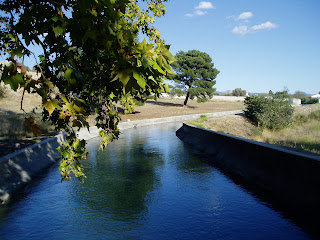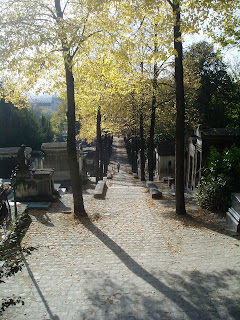For one of my classes I am studying the unique city of Marseille, in the South of France. As part of the class, of course, we had to spend a few days there. Here is a little summary of some things I did and saw:

This is one of the first things I saw on the morning of the first day: The Church St. Victor, home of France's oldest abbey (dating back to the 3rd century BC). The structure and the relics inside were easily the oldest man-made creations I have seen.

What I found most fascinating were the cabinet of relics, which included the front of a saint's skull, and this sarcophagus of another saint, which had a human skull built into the stone work!
Next we trekked up to Notre Dame de la Garde, Marseille's most famous church. The view from the top was incredible - all brilliant blues

and jagged landscape.

Later that day, we visited a little-known part of Marseille, guided by a specialist from a nearby university. Apparently in the 17 and 1800s it was the fashion to have what was called a "bastide" - a manor surrounded by a garden, not unlike the plantation we have in the States. However, due to the dry climate of Marseille, irrigation channels and a canal had to be built in order to create the lush landscapes that I attempted to capture in my photos:


These areas were right inside the city. We wandered in the forest and countryside for a good few hours, and the entire time it felt like I was in some sort of fantasy land. I felt very privileged to see a side of the city that even the residents themselves know very little about.
Exhausted after all of the walking, most of the group returned to the hotel or went out to dinner. The next day would prove to be even more interesting...

This is the Friche de la Belle de Mai. It was a cigarette factory, but now it is an artist hive that until very recently was funded by the state. All kinds of art are produced here: painting, graffiti, theatre, poetry, metalwork, radio transmissions...Many of the artists live on the site, and use the materials from the old factory to make their work. There are rooms for theatre rehearsal, welding, radio, and even a cafe in which all the furniture and installations were made by the artists on site. Being here I thought of all the factories one sees closed down along the East Coast and in the Midwest in America, and how a program like this could greatly benefit those areas. And to imagine, the state funded this program! The community supports it, and all of the productions become open to the public at the Friche. What's more, apparently these sites are all over Europe. Perhaps this is one of the many benefits of a culture that esteems art and intellectualism...
After the Friche, we walked along the Docks, where many of the old warehouses had been converted into business offices. The architecture was interesting here, but the area seemed sadly under-utilized. There were no restaurants, cafes, or apartments - just dull, depressing offices. It's important to see this part of Marseille to know its not all some Mediterranean melange of art and partying, but I was happy to move into the Pannier (the Basket), the oldest neighborhood of the city.

This is the area of Marseille that was founded by the Phoenicians, meaning the city actually pre-dates ancient Greece! It was all narrow, winding streets on inclines. Much as I imagine streets in Greece to be. It was an interesting change from the grand boulevards of Paris.
Saturday night, my professor took us all out to a concert of a Marseilleais folk legend. The atmosphere was very un-pretentious and laid back. Some people danced, some people just watched. There was no sense of judgment; merely enjoyment. How many concerts have I had ruined by the opposite atmosphere?
Moreover, I never imagined I'd go to a concert with my one of my college professors! She was dancing and drinking wine with the rest of us. I guess I just need to have a bigger imagination - France keeps stretching mine out of shape!
Sunday we all dragged ourselves out of bed to go on a boat tour of the calanques. Calanques are a geographic structure essentially unique to Marseille. They are very similar to fjords, though smaller. One can find them all around Marseille, each with a little port at the back. Leaving the Vieux Port of Marseille, I saw up close the Chateau d'If, made famous by being the place where Edmund Dantes is imprisoned in the Count of Monte Cristo:

And here is a typical calanque:

Hard to believe that people actually etch out a living amongst these rocks and shrubs; though maybe they come into Marseille and wonder the same thing about the city-folk. As for the city folk of Marseille, I have to say they reminded me a lot of Bostonians. That's to say, they have a very gruff, prickly exterior - but often they are nicer than they seem.
This wasn't always the case, though. My friend Sylvie was insulted at a restaurant because she asked for ketchup for her French fries. I believe the words of the waiter were "Oh you are an American! Bang bang John Wayne! Cowboy! Hot dog!" Luckily, Sylvie had the dignity and the cool to inform the man that he was being rude and to leave the restaurant without saying another word. Apparently the rest of the restaurant's patrons took her side, as well. Still, it's unfortunate that these things happen, and it's a reminder that while abroad, I represent something much more than just my own personal history - I represent an entire culture, nation, and, unfortunately, government. This is the downside of democracy - when the rest of the country votes against your preference, you have to foot the bill for their choice, because it was the choice of the majority...and the rest of the world knows that.

In any case, the last stop of our trip was La Cité Radieuse, a sort of urban utopia designed by the famous architect Le Corbusier. This skyscraper at the edge of Marseille was built to be a self-inclusive habitation with affordable and comfortable housing. There used to be stores, coiffures, restaurants, even a school and daycare inside. In the picture above, you can see what used to be the school on the right. Unfortunately, the space became chic and trendy, the bourgeois took over, and it was no longer so affordable. The shops disappeared, the school closed, and a hotel claimed part of the building. The community was gone, but the structure remained. It was absolutely fascinating to go inside and up to the roof, seeing this husk of a utopia amidst the decidedly avant-garde design of Le Corbusier. The roof was almost a concrete park, with plenty of places to sit or lay. And the view of Marseille was unparalleled. Unfortunately, my camera's battery was dying by this point in the trip, so my photographs are far too few.
After that, we returned to Paris, exhausted and happy to be going back. It was odd to long for a place that wasn't technically my home, to call it "home" only because it was slightly more comfortable and less foreign than where I had been. Last night I hung out on the Pont des Arts with a friend to watch the lights dance on the Seine because I missed them; it was an odd experience, really. I've missed Boston or even Atlanta before, but never in that way. I missed them because they were familiar, not because they were beautiful or intoxicating. Paris is rated an Alpha World City for this reason - you don't have to speak the language to be embraced by its charm and splendor.












